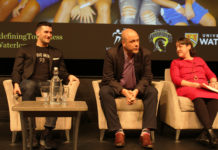The monkeypox virus was declared a Global Public Health Emergency on July 23, 2022 and was soon covered with the comparison with the HIV/AIDS crisis. There is a strong parallel between both of the diseases — similar to the beginning of the HIV/AIDS epidemic, the knowledge around the monkeypox virus is limited and uncertain.
Endemic to certain African countries, the monkeypox virus was first identified in a colony of monkeys in Copenhagen, Denmark, in 1958 and is a viral zoonosis, which means that it’s transmitted to humans from animals. The first human contraction was identified in a young child in the Democratic Republic of the Congo in 1970.
The monkeypox virus is transmitted from one person to another by close contact with lesions, bodily fluids, respiratory droplets and contaminated materials such as bedding. The virus is also known to be a self-limiting virus but it is suspected that there is little to no immunity against the virus in people living in non-endemic countries.
The emergence of the monkeypox virus has not only led to certain assumptions in the transmission methods but also assumptions that target the 2SLGBTQ+ community, in ways that may be similar to that of the 80’s AIDS crisis.
In the 1900s the world witnessed a horrifying HIV/AIDS (Human Immunodeficiency Virus/Acquired Immunodeficiency Disease Syndrome) pandemic which claimed more than 150,000 lives in the U.S. alone. The news is often now seen in comparison with a relatively newer pandemic — the human monkeypox virus.
The first five cases of HIV/AIDS suspected as Pneumocystis Pneumonia were reported in five young men who identified as gay, in Los Angeles, California in the period of October 1980 to May 1981. Almost all of them were affected with cytomegalovirus infection, which causes inflammation, and with candidal mucosal infection that primarily affects the oral cavity, esophagus tract, nail beds and genitals. They were treated at three different hospitals in Los Angeles where two patients ended up losing their life to the virus.
The first publicized cases along with the biases of the general public gave birth to a stigma around the situation despite knowing that AIDS was also transferred through intravenous drug users who shared needles, blood transfusion patients, and people with infected sexual partners. Lack of resources and funding gave rise to a homophobic mainstream culture which impacted the way AIDS was dealt within the public.
With hundreds marked with fear about the uncertainty revolving around their current situation, the situation became more critical when the media portrayed metaphorical depictions that were sexist and homphobic on top of moralistic images. The fear around the disease was stigmatized to a certain point that it wasn’t until September of 1982 that the CDC adapted and started using the term “AIDS” for the first time.
Many activists and non-profit organizations rose such as ACT UP (AIDS Coalition to Unleash Power) which was organized in 1987 to respond to the U.S. government’s handling of the AIDS crisis with aggressive, nonviolent, direct action.
The risks with the monkeypox virus are significant and in addition to the few resources available to respond to the outbreak, the perception could put 2SLGTBQ+ people at direct risk. Nurse scientist and the inaugural leadership and innovation endowed chair at the Johns Hopkins University School of Nursing, Jason Farley made a connection to the AIDS crisis.
“If we look at how the AIDS response unfolder, for example, it took almost a decade to fet the heterosexual community to pay attention and realize that HIV was not a gay disease,” Farley said in an email to CNN. It is imperative that a repetition of history with the same form of inaccurate information is not the guiding factor for public health practice.
A senior scholar at the Johns Hopkins Center for Health Security at Johns Hopkins Bloomberg School of Public Health, Dr. Amesh Adalja, elaborated on the transmission mechanism of the monkeypox virus.
“Many infectious diseases, although we will classify them in one manner of transmission, have multiple mechanisms of transmission,” Adalja said.
He added that even though monkeypox is sexually transmitted it is clearly spreading through other ways as well. It is also imperative to make people conscious of the potential risks so that informed decisions can be made, but being compassionate and considerate in the tone is essential to not stigmatize people for their sexual activity and behaviour.
Chaya Mamer, a third-year ARBUS and political science student, acknowledges the atrocities surrounding the 80’s crisis and doesn’t want them to be repeated.
“After the Stonewall riot in the sixties our parents’ generation lived through watching acceptance and stigmatization during the HIV aids pandemic and now we’re seeing an opportunity in an age of Acceptance, Now we have to challenge the recurring situation of stigmatization happening again,” Mamer said.
In an International AIDS Conference (AIDS 2022) hosted in Montreal, some advocates said that the health officials need to prevent a recurring perception that a viral threat, like HIV/AIDS or monkeypox, only affects a marginalized portion of the population.
Learning from the history of AIDS activism would require time and capacity but would yield a great sense of care and responsibility towards the health of every individual around the world.































